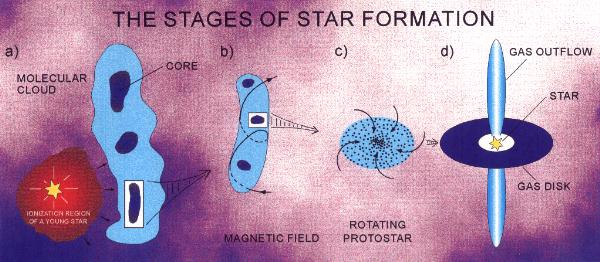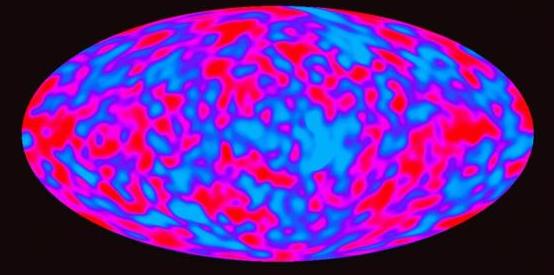Back to  .
.
What can you do with a Submillimeter
Telescope?
Submillimeter astronomy promises to yield a new view upon the Universe
we live in, almost certainly shedding light upon many of the
outstanding questions in modern astronomy.
Among the most pressing of these questions is how stars are formed.
Stars are born from the material between other stars. In some regions
of space, the density of gas and dust is much higher than the norm,
and atoms are sufficiently shielded from destructive high-energy
photons to
interact with other atoms to form simple molecules. In the highest
density central regions of such molecular clouds, material is
so well
shielded that delicate, complex molecules can form. It is from these
molecular cloud cores that new stars (including our own Sun) are
born. The study of the chemistry in such regions can not only lead to
an improved understanding of the physical conditions in such a
"stellar nursery", but also can provide clues to the
composition of
other star-forming (and possibly planet-forming and life-giving)
solar systems. Such studies may help astronomers understand the
conditions from which life evolved on Earth.
Because the star forming process occurs behind so much intervening
dusty material, visible-light telescopes cannot see what is
happening. By moving to the infrared, sub-millimeter and millimeter
wavelength regions, where the effects of this obscuration are nearly
negligible, astronomers can begin to directly probe regions where
stars are actively being born.
Understanding the star forming process has many astronomical
consequences. Knowing what physical conditions are needed to form
molecular cloud complexes is important in understanding the
star-forming evolution of galaxies, both in the current age and,
perhaps most importantly, when galaxies were first forming. The
understanding of how a single star forms from a molecular cloud, then,
has
even cosmological implications.
 The current working model for star formation may be represented by four
conceptually distinct stages of development that are the culmination of
the last several decades of theoretical and observational efforts.
Within molecular clouds, there are cores of material which are denser
than the surrounding cloud. Dense molecular condensations form within these
molecular cores as the loss of magnetic support through ambipolar diffusion
allows gas and dust to contract gravitationally.
Eventually these condensations become sufficiently centrally concentrated to
undergo dynamical collapse; the inner regions form
an evolving protostar and surrounding disk while the outer regions
form an extended infalling envelope of material (the arrows). At some point,
a bi-polar wind breaks out along the rotational poles of the
system, while material continues flowing inward along the equatorial
regions. The visual extinction toward the central protostar is typically
tens to thousands of magnitudes at this point, effectively obscuring it
from scrutiny at optical wavelengths.
Over time, the angle occupied by the wind broadens, removing surrounding
material and halting the inward flow of material. At this point, the system
becomes detectable at near-infrared and even optical wavelengths as a star
plus a disk, commonly recognized as a T Tauri system.
The current working model for star formation may be represented by four
conceptually distinct stages of development that are the culmination of
the last several decades of theoretical and observational efforts.
Within molecular clouds, there are cores of material which are denser
than the surrounding cloud. Dense molecular condensations form within these
molecular cores as the loss of magnetic support through ambipolar diffusion
allows gas and dust to contract gravitationally.
Eventually these condensations become sufficiently centrally concentrated to
undergo dynamical collapse; the inner regions form
an evolving protostar and surrounding disk while the outer regions
form an extended infalling envelope of material (the arrows). At some point,
a bi-polar wind breaks out along the rotational poles of the
system, while material continues flowing inward along the equatorial
regions. The visual extinction toward the central protostar is typically
tens to thousands of magnitudes at this point, effectively obscuring it
from scrutiny at optical wavelengths.
Over time, the angle occupied by the wind broadens, removing surrounding
material and halting the inward flow of material. At this point, the system
becomes detectable at near-infrared and even optical wavelengths as a star
plus a disk, commonly recognized as a T Tauri system.
A microwave-sensitive telescope like the SMT can also probe the
edge
of the observable Universe directly, which is of interest to
cosmologists. One of the great success stories of the Big Bang model
has been the detection of the Cosmic Microwave Background Radiation
(CMBR). This radiation stems from about 1 million years (virtually a
blink of an eye, cosmologically speaking) after the Big Bang, when the
Universe had expanded and cooled to an extent that atoms could form;
leaving light waves to travel freely through space. Until that point,
the Universe was ionized, and too dense and hot for light to travel
far without interacting with matter. The so-called "last scattering
surface" marks the epoch when the Universe became "transparent" and
not "opaque". The radiation from this epoch has been shifted in
wavelength due to the continued expansion of the Universe, now
appearing in the microwave region of the spectrum, and is observable
with radio telescopes like the SMT.
 This is an image of the CMBR, taken by COBE. The irregularity apparent
here is somewhat exaggerated; the scaling in this plot shows
irregularities smaller than one-ten-thousandth of a degree (K)! These
bumps are the seeds from which galaxies are thought to have formed.
This is an image of the CMBR, taken by COBE. The irregularity apparent
here is somewhat exaggerated; the scaling in this plot shows
irregularities smaller than one-ten-thousandth of a degree (K)! These
bumps are the seeds from which galaxies are thought to have formed.
The existence of the CMBR is not new, and it has been well
characterized by orbiting microwave satellites like the Cosmic
Microwave Backround Explorer (COBE) on large spatial scales of many
degrees. We now know that this background radiation is very smooth,
but that there are "irregularities" in the radiation that many believe
are the density perturbations, the seeds, if you will, that
later formed galaxies. The characterization of this microwave
background on small angular scales can help theorists differentiate
between theories of galaxy and structure formation. How did we get
here? is a question that permeates much astronomical thought!
<-- Back to General Info
Last modified: Mon Dec 9 23:19:32 MST 1996
 The current working model for star formation may be represented by four
conceptually distinct stages of development that are the culmination of
the last several decades of theoretical and observational efforts.
Within molecular clouds, there are cores of material which are denser
than the surrounding cloud. Dense molecular condensations form within these
molecular cores as the loss of magnetic support through ambipolar diffusion
allows gas and dust to contract gravitationally.
Eventually these condensations become sufficiently centrally concentrated to
undergo dynamical collapse; the inner regions form
an evolving protostar and surrounding disk while the outer regions
form an extended infalling envelope of material (the arrows). At some point,
a bi-polar wind breaks out along the rotational poles of the
system, while material continues flowing inward along the equatorial
regions. The visual extinction toward the central protostar is typically
tens to thousands of magnitudes at this point, effectively obscuring it
from scrutiny at optical wavelengths.
Over time, the angle occupied by the wind broadens, removing surrounding
material and halting the inward flow of material. At this point, the system
becomes detectable at near-infrared and even optical wavelengths as a star
plus a disk, commonly recognized as a T Tauri system.
The current working model for star formation may be represented by four
conceptually distinct stages of development that are the culmination of
the last several decades of theoretical and observational efforts.
Within molecular clouds, there are cores of material which are denser
than the surrounding cloud. Dense molecular condensations form within these
molecular cores as the loss of magnetic support through ambipolar diffusion
allows gas and dust to contract gravitationally.
Eventually these condensations become sufficiently centrally concentrated to
undergo dynamical collapse; the inner regions form
an evolving protostar and surrounding disk while the outer regions
form an extended infalling envelope of material (the arrows). At some point,
a bi-polar wind breaks out along the rotational poles of the
system, while material continues flowing inward along the equatorial
regions. The visual extinction toward the central protostar is typically
tens to thousands of magnitudes at this point, effectively obscuring it
from scrutiny at optical wavelengths.
Over time, the angle occupied by the wind broadens, removing surrounding
material and halting the inward flow of material. At this point, the system
becomes detectable at near-infrared and even optical wavelengths as a star
plus a disk, commonly recognized as a T Tauri system.
 .
.
 This is an image of the CMBR, taken by COBE. The irregularity apparent
here is somewhat exaggerated; the scaling in this plot shows
irregularities smaller than one-ten-thousandth of a degree (K)! These
bumps are the seeds from which galaxies are thought to have formed.
This is an image of the CMBR, taken by COBE. The irregularity apparent
here is somewhat exaggerated; the scaling in this plot shows
irregularities smaller than one-ten-thousandth of a degree (K)! These
bumps are the seeds from which galaxies are thought to have formed.